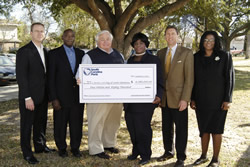POSTED ON BEHALF OF: The City of North Charleston, Lowcountry Alliance for Model Communities & The South Carolina State Ports Authority
The Ports Authority's $4 million will fund a host of programs in the area, ensuring the new port terminal at the former Navy Base has the greatest positive impact on the surrounding area. Earlier this year, nine state and federal agencies signed off on the new port development project at the former Navy Base.
"The negotiations between the neighborhoods, City and SPA ended with the neighborhoods gaining an opportunity to enhance the value, conditions, and livability of their community," said Mayor Summey. "The mitigation provides a wonderful and unique chance to allow the neighborhoods to guide and mold their future."
The massive community mitigation program is result of a working partnership between the City of North Charleston, the community and the Ports Authority. Over several months, the City and the Lowcountry Alliance for Model Communities, a group of seven neighborhoods near the terminal site, worked with the Ports Authority to minimize negative impacts and maximize positive impacts.
The resulting agreement, which was signed by the neighborhoods, the City and the Ports Authority, calls for the Ports Authority to fund $4.08 million in community, neighborhood and economic development projects.
This approach was quite unique. While most major projects include traditional "green" mitigation for wetlands and other impacts, this is one of the first port expansion projects on record that focused on community efforts as part of the formal mitigation plan.
Specific community priorities that will be funded through this effort include:
Bernie Groseclose, president & CEO of the South Carolina State Ports Authority, delivered the first $750,000 installment to Mayor Summey earlier today. Annual payments of $300,000 will follow until the project is completed in 2013.
"Port development means good things for the economy, for the environment and for the community," said Groseclose. "LAMC showed a deep concern for its community and a desire to enact change. We feel honored to have started this relationship and look forward to growing it together."
"I always believed that the new port terminal would be a positive for my community because of its economic development opportunities," says Thomasina Green, Union Heights Neighborhood President and Vice President of LAMC. "I along with the other neighborhood presidents decided to work with the City of North Charleston and the SPA to mitigate potential undesirable environmental impacts. LAMC members, most with no prior environmental or transportation planning experience, had to teach ourselves NEPA policies particularly those pertaining to environmental justice. We did not receive any assistance from environmental advocacy groups including the Coastal Conservation League at any time during the assessment phase. While we were concerned about air quality, there were other environmental issues as equally important to us: diminished housing values, environmental protection during construction, and the port access road alignment. We did not spend countless hours in meetings for our benefit, but to benefit the residents of our communities for generations to come."
The community mitigation is part of a larger $12-million mitigation program to offset impacts of the Ports Authority's new container terminal at the former Navy Base. The mitigation program was an essential element of the project's ultimate approval.
